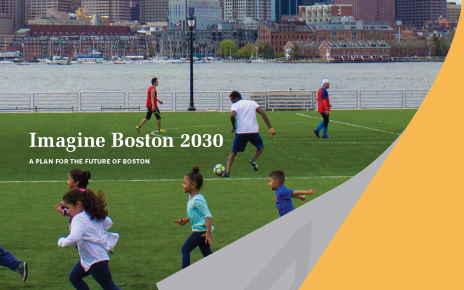Imagine Boston 2030, the city’s first master planning effort in over 50 years was released, in draft form, by Mayor Walsh’s office. The document comes after an outreach effort with over 12,000 participants (such as this North End session).
The strategic vision is headlined Expanding Opportunity, focusing on housing and job growth to meet an increasing population. The Walsh administration is prioritizing neighborhood development, both in the downtown core as well as underutilized pockets in new communities such as Widdet/Newmarket, Beacon Yards (Allston), Sullivan Square (Charlestown), Readville (Hyde Park) and Suffolk Downs. Existing downtown neighborhoods including the North End, Back Bay and South End are labeled as “enhanced” implying mostly fill-in opportunities. Boston’s waterfront is a centerpiece of the plan, both in proactive climate change planning and for new open spaces and mixed development.
“Imagine Boston 2030 offers a citywide perspective of Boston’s future that ties together our many planning initiatives already underway to guide strategic growth and expand opportunity for all residents,” said Mayor Walsh. “I am excited to launch a draft plan that identifies ways to strengthen neighborhoods and support growth for many years to come. This plan represents the voice of thousands of residents who shared their thoughts, and I look forward to continuing the conversation so together we can build the future of Boston.”
Boston’s population is estimated to grow by 70,000 to over 724,000 by 2030 and ultimately 800,000 people by 2050. An additional 53,000 housing units would be needed to support the 2030 plan.
Creating affordable deed-restricted housing, reduce income inequality and incorporating “smart city” technology infrastructure are highlights in the vision plan. Education and economic mobility through expanded programs for pre-K, community college, small business initiatives and financial education.
City Hall continues to emphasize bike and pedestrian-friendly “safe streets” along with its health initiatives including substance abuse and mental health care.
Completing the Emerald Necklace, strengthening Boston Common and Franklin Park are the focus of the parks and open spaces section. For transportation, improving the T and completing the Fairmont corridor are priorities. Lastly, the plan includes creating local arts hubs.
The 24-page Executive Summary of the Imagine Boston 2030 plan is shown below. For the full document, download the (very large) pdf here. Feedback on the draft can be submitted via the Imagine Boston survey with a final report expected in the Spring 2017.






































